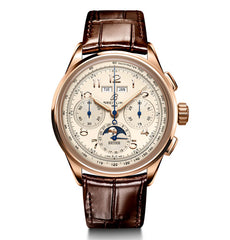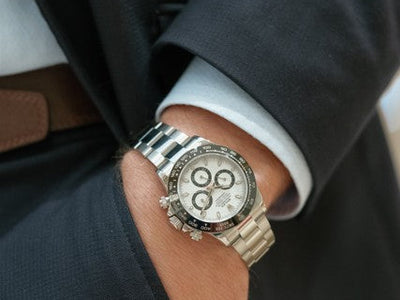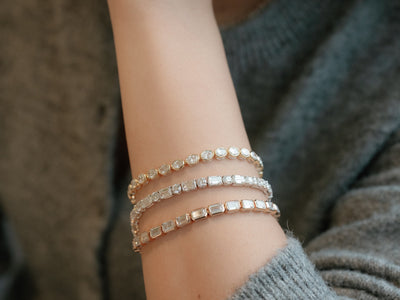There’s a reason why watches are so collectible. Once you understand the craftsmanship behind each part of a watch, it’s hard not to appreciate the intricate details in the different types of wristwaches. While most of us won’t become avid watch collectors or horological experts, we believe that everyone can benefit from some basic understanding of this impressive timekeeper.
What are the Different Types of Wristwatches?
Watches come in a seemingly endless array of shapes, sizes, and styles, but these timepieces can be roughly grouped into two broad categories based on how they display the time. These two primary types of wristwatches are analog and digital, and these groupings refer to the way the timepiece displays the time.
Analog and digital watches can be further categorized into many more specific types of wristwatches. Watches may be grouped according to a number of different features, including watch movement type, water resistance, strap style, and complications.
Analog Watches vs. Digital Watches
Analog watches are the oldest type of wristwatch and feature rotating hands that display the hour, minute, and seconds. Women’s and men’s watches have been crafted in this fashion for centuries, and the parts of a watch have been relatively standard for generations.
During the 1970s, however, the traditional analog watch met fierce new competition with the advent of the digital watch. This new type of wristwatch displayed the time in a segmented display of numbers and introduced the use of batteries in watchmaking.
The analog watch is the mainstay for those who appreciate traditional craftsmanship, but the digital watch and the array of technological capabilities it offers is a practical solution for the busy modern consumer. Each of the different types of wristwatches has its advantages that are worth considering.
What is Watch Movement?
Watch movement refers to the internal parts of a watch that power an analog timepiece and any of its additional features, called complications. The watch movement is also referred to as its calibre, and luxury watchmakers pride themselves on their tested watch movements with specific names and certifications.
The parts of a watch that compose its movement create an intricate system of gears and coils that require precise craftsmanship and incredible skill. These watch movements are often tested at the Contrôle Officiel Suisse des Chronomètres (COSC) or the Swiss Federal Institute of Metrology for the organization’s coveted METAs certification. Many watch aficionados and collectors prefer analog watches over digital watches because of this long tradition of craftsmanship in these types of wristwatches.
What Are the Different Types of Watch Movements?
Analog watches are available with three types of movement: mechanical, automatic, and quartz. The oldest wristwatch types featured mechanical watch movements, which was the longstanding foundation of watchmaking but met stiff competition with technological advancements in the 1960s.
Mechanical Watch Movements
The mechanical watch movement is the traditional style calibre most people think of when they picture the inner parts of a watch. Mechanical watch movements feature a tightly wound mainspring within the confines of a barrel. This mainspring is connected to various gears that, in turn, power the watch’s hands.
Mechanical watches are often the preferred calibre for those who desire a watch that exudes both history and luxury. Part of the charm of these types of wristwatches is the process of winding it. The mainspring must be wound by hand using the crown. Different watches have different power reserves, but generally, you should expect to wind a mechanical watch every day or two.
Our favorite luxury mechanical watches include:
Automatic Watch Movements
The automatic watch movement, invented in the 1920s, provided an innovative solution to winding a mechanical watch daily. These new types of wristwatches featured a rotating inner weight that would wind the mainspring as the wearer moved about during the day.
Automatic watches combine the craftsmanship of a traditional mechanical watch with modern innovation to create a true gem that will make you consider making your next watch an automatic.
Our favorite timepieces that feature automatic watch movements include:
What is a Watch Winder?
A helpful accessory for automatic movement watches is a watch winder, especially if you have a collection of watches or won’t be wearing your timepiece daily. A watch winder is a storage device that gently rotates an automatic watch to mimic the movements of daily wear, engaging the watch’s automatic winding feature even when you’re not using it.
Quartz Watch Movements
The advent of the quartz watch movement forever changed the watchmaking industry, making precision luxury timepieces more affordable and accessible to consumers. Both the mechanical and automatic types of wristwatches rely on gears and a precisely unwinding mainspring to time the movement of the watch hands. However, the quartz watch movement used a novel approach, applying electricity from a battery to a quartz crystal to create precise vibrations used for timing.
This innovation resulted in watch movements that were less expensive to create and that were even more accurate than previous mechanical watches. The Swiss watch industry was initially reluctant to adopt this new type of wristwatch, which nearly caused the collapse of the industry as the new quartz watch movement gained traction with consumers.
Our favorite quartz watches include:
What are the Parts of a Watch?
Watches may seem like simple devices for a simple function—their basic job is to keep accurate time. The process of achieving this feat, however, requires skill, patience, and extreme precision. The inner parts of a watch are incredibly intricate. The additional features and functions of luxury watches, called complications, can add dozens more components. Some luxury watches can include over 400 parts!
While you don’t need to know all parts of a watch from A to Z to make an informed choice or to maintain your timepiece, it is helpful to have a general understanding of the watch’s outer construction to help you diagnose any issues and appreciate the distinctive design elements on different timepieces.
Externally Visible Parts of a Watch
These visible parts of a watch are common across most timepieces. Understanding these different components will help you make an informed choice about your style preferences and help you ask questions.
- Dial: The “face” of the watch, upon which rests the hour markers, hands, brand signature, and many of the other visible parts of a watch.
- Case: The outer hull of the watch, which surrounds its inner workings, including the mainspring or battery, depending on the type of wristwatch.
- Bezel: The often flat, but sometimes rounded, ring that surrounds the watch face and connects the case to the lugs. The bezel is sometimes embellished with diamonds or other precious stones.
- Crown: The screw-shaped dial on the side of the watch case used to change the time. In water-resistant watches, the crown screws down into the watch case to create a watertight seal.
- Hands: These parts of a watch rotate around the dial to mark the hours, minutes, and seconds in an analog watch.
- Crystal: The clear window that protects the dial from dust and dirt.
- Strap/bracelet: The means by which the watch is secured to the wrist – common materials include metal, leather, rubber, and fabric.
- Lugs: The means by which the watch case is connected to the strap.
- Buckle/clasp: The fastener that connects the two sides of a watch strap or bracelet.
Popular Watch Complications
Watch complications can be simple or complex and are largely a matter of personal preference. The watch movement, the part of a watch that powers the timekeeping function, is also responsible for powering these complications. Common watch complications include:
- Date display
- Chronograph
- Dual time
- Moon phase
- World time
- Power reserve indicator
- Tourbillon
Watch Styles for Every Occasion
A watch’s timekeeping ability isn’t the only factor when selecting a designer timepiece. Often, where you plan to wear the watch and the activities you engage in will be the primary drivers for your choice. It is important to match the type of wristwatch you choose to your lifestyle needs, whether that be a casual wear watch, a dress watch, or a rugged sports watch.
Watches for Causal Wear
Casual wear watches don’t simply mean basic. Often, these types of wristwatches are anything but! In this category, you’ll find comfortable watches for everyday living.
High-quality materials like stainless steel make a sharp impression and are durable. You may prefer a quartz movement, as these cases are typically slimmer, lighter in weight, and can boast some practical digital features.
Dress and Fashion Watches
Dress watches marry function and stunning form to celebrate the watch as not only a timepiece but also a fashion accessory. These wristwatch types often feature precious metals and gemstones like diamonds. They may not have any water resistance, however, which means that you’ll need to take great care with everyday tasks like handwashing.
Sport and Diving Watches
A sportsman often makes strenuous demands on a timepiece, which is why you should take special care when selecting a watch that you plan to use to support your outdoor activities. These wristwatch types typically feature exceptional water resistance and rugged case and strap materials. Sports watches may also feature additional watch complications like a chronograph or dual timekeeping that can be helpful in sporting activities.
One highly specialized sports watch is the diving watch, which actually has its own set of requirements set by the International Standards Organization. These requirements state that in order to be marketed and sold as a diving watch, a timepiece must resist water to a depth of 100 meters, employ a secured mechanism to measure dive time, and feature luminous elements that are visible in underwater darkness.
What is Watch Resistance?
Watch resistance refers to the ability of the watch to resist water intrusion. The delicate internal parts of a watch can be destroyed by water, so if you plan to use your watch in or around water in any way, pay special attention to the watch’s resistance.
Resistance is typically measured in meters or bars, which simply refers to the pressure that correlates to an underwater depth. The most water-resistant types of wristwatches are meant for deep diving, like the Omega Seamaster Planet Ocean, which boasts an astounding resistance of 6,000 meters.
Watch Water Resistance Levels
- 0 meters: This type of wristwatch is not water resistant. Take care with everyday tasks.
- 30 meters: This watch resistance is a good safeguard against handwashing and rain showers.
- 50 meters: These watches can tolerate gentle swimming and submersion.
- 100 meters: This is the minimum water resistance allowed for a diving watch; good for snorkeling and swimming.
- 200+ meters: We recommend a resistance of at least 200 meters for true scuba diving.
How to Maintain Watch Resistance
Water-resistant watches are constructed with special rubber gaskets, or O-rings, that protect them from water intrusion around the case joints. Some of these joints include where the watch crystal and back meet the case and around the watch stem.
While these gaskets do a great job of preventing water intrusion, they can become dry and brittle over time, reducing their effectiveness. It is important to schedule routine service at a trusted jeweler to ensure that your Swiss-made watch maintains its water resistance. A jeweler can perform a water resistance test as well as address other common watch problems that can compromise your watch’s water resistance.
What Watch Maintenance Services Do I Need?
Designer watches are crafted to last a lifetime—and beyond. These treasured pieces often become family heirlooms and are enjoyed for generations. To preserve the integrity of your Swiss watch and ensure you enjoy its full lifespan, schedule routine watch maintenance with a reputable jeweler.
A skillful jeweler should be able to address any watch maintenance and repair needs that you may have, from simple battery changes for your quartz wristwatch to full overhauls in your Swiss-made mechanical watch. Occasionally, you may need to have your watch case opened and the internal mechanism cleaned, which is certainly best left to a professional.
Your jeweler can also update your luxury timepiece by changing the strap or bracelet and can sometimes add or remove watch links to adjust the sizing. These parts of a watch are often overlooked but can make a big difference in the comfort of your timepiece. Scratches, loose gemstones, and other cosmetic damage can also usually be rectified. These repairs should be undertaken as soon as you notice the damage to minimize the cost and overall harm to the piece.
Can I Change My Own Watch Battery?
To keep your watch looking and functioning its best, see a jeweler for regular battery replacement instead of changing it yourself. This is especially important if your watch is water resistant, as changing the watch battery involves opening the case, which can compromise the seal of the rubber O-ring gaskets and risk damage to the inner parts of a watch.
With this knowledge about the various features and parts of a watch, you’ll be well-equipped to make an informed decision about the type of wristwatch that is right for you. Whether you choose a quartz movement with a sleek, modern digital display or a time-honored, hand-wound, Swiss-made mechanical with a chronograph, you’re sure to love your timepiece for a lifetime.













